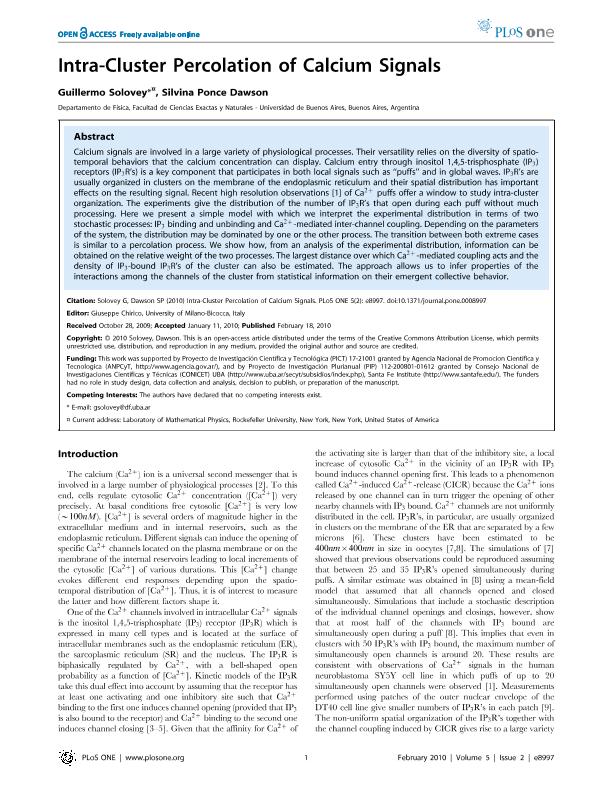Mostrar el registro sencillo del ítem
dc.contributor.author
Solovey, Guillermo

dc.contributor.author
Ponce Dawson, Silvina Martha

dc.date.available
2018-08-24T17:48:08Z
dc.date.issued
2010-12
dc.identifier.citation
Solovey, Guillermo; Ponce Dawson, Silvina Martha; Intra-cluster percolation of calcium signals; Public Library of Science; Plos One; 5; 2; 12-2010; 8997-8997
dc.identifier.issn
1932-6203
dc.identifier.uri
http://hdl.handle.net/11336/57027
dc.description.abstract
Calcium signals are involved in a large variety of physiological processes. Their versatility relies on the diversity of spatiotemporal behaviors that the calcium concentration can display. Calcium entry through inositol 1,4,5-trisphosphate (IP3) receptors (IP3R's) is a key component that participates in both local signals such as "puffs" and in global waves. IP3R's are usually organized in clusters on the membrane of the endoplasmic reticulum and their spatial distribution has important effects on the resulting signal. Recent high resolution observations [1] of Ca2+ puffs offer a window to study intra-cluster organization. The experiments give the distribution of the number of IP3R's that open during each puff without much processing. Here we present a simple model with which we interpret the experimental distribution in terms of two stochastic processes: IP3 binding and unbinding and Ca2+-mediated inter-channel coupling. Depending on the parameters of the system, the distribution may be dominated by one or the other process. The transition between both extreme cases is similar to a percolation process. We show how, from an analysis of the experimental distribution, information can be obtained on the relative weight of the two processes. The largest distance over which Ca2+mediated coupling acts and the density of IP3-bound IP3R's of the cluster can also be estimated. The approach allows us to infer properties of the interactions among the channels of the cluster from statistical information on their emergent collective behavior. © 2010 Solovey, Dawson.
dc.format
application/pdf
dc.language.iso
eng
dc.publisher
Public Library of Science

dc.rights
info:eu-repo/semantics/openAccess
dc.rights.uri
https://creativecommons.org/licenses/by-nc-sa/2.5/ar/
dc.subject
Puffs
dc.subject.classification
Otras Ciencias Biológicas

dc.subject.classification
Ciencias Biológicas

dc.subject.classification
CIENCIAS NATURALES Y EXACTAS

dc.title
Intra-cluster percolation of calcium signals
dc.type
info:eu-repo/semantics/article
dc.type
info:ar-repo/semantics/artículo
dc.type
info:eu-repo/semantics/publishedVersion
dc.date.updated
2018-08-24T13:45:41Z
dc.journal.volume
5
dc.journal.number
2
dc.journal.pagination
8997-8997
dc.journal.pais
Estados Unidos

dc.journal.ciudad
San Francisco
dc.description.fil
Fil: Solovey, Guillermo. Consejo Nacional de Investigaciones Científicas y Técnicas. Oficina de Coordinación Administrativa Ciudad Universitaria. Instituto de Física de Buenos Aires. Universidad de Buenos Aires. Facultad de Ciencias Exactas y Naturales. Instituto de Física de Buenos Aires; Argentina
dc.description.fil
Fil: Ponce Dawson, Silvina Martha. Consejo Nacional de Investigaciones Científicas y Técnicas. Oficina de Coordinación Administrativa Ciudad Universitaria. Instituto de Física de Buenos Aires. Universidad de Buenos Aires. Facultad de Ciencias Exactas y Naturales. Instituto de Física de Buenos Aires; Argentina
dc.journal.title
Plos One

dc.relation.alternativeid
info:eu-repo/semantics/altIdentifier/url/http://www.plosone.org/article/info%3Adoi%2F10.1371%2Fjournal.pone.0008997
dc.relation.alternativeid
info:eu-repo/semantics/altIdentifier/url/http://journals.plos.org/plosone/article?id=10.1371/journal.pone.0008997
dc.relation.alternativeid
info:eu-repo/semantics/altIdentifier/doi/http://dx.doi.org/10.1371/journal.pone.0008997
Archivos asociados
